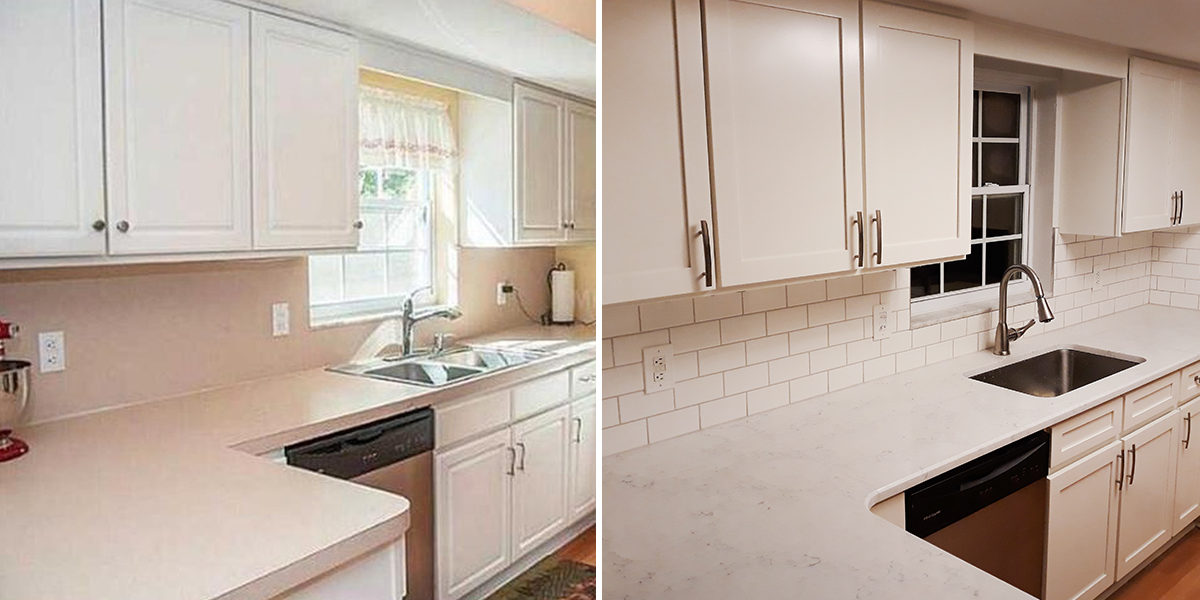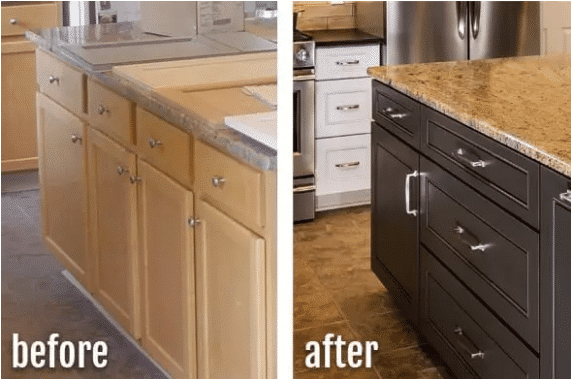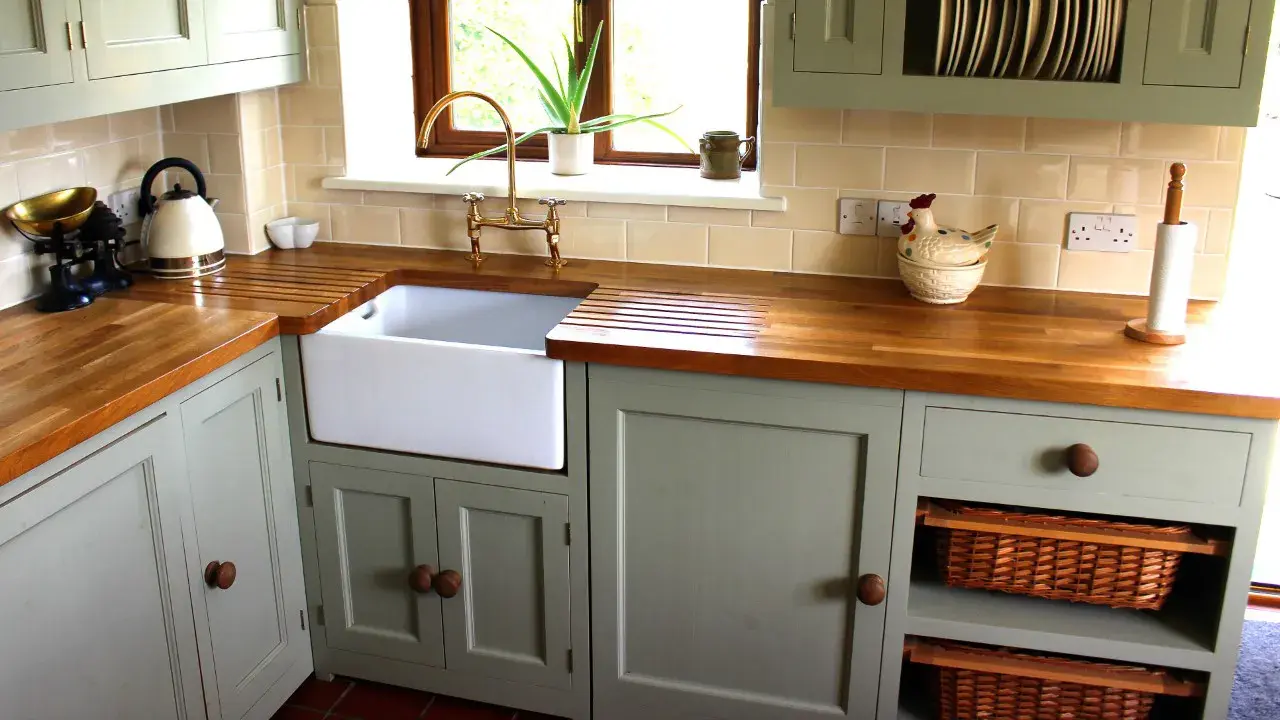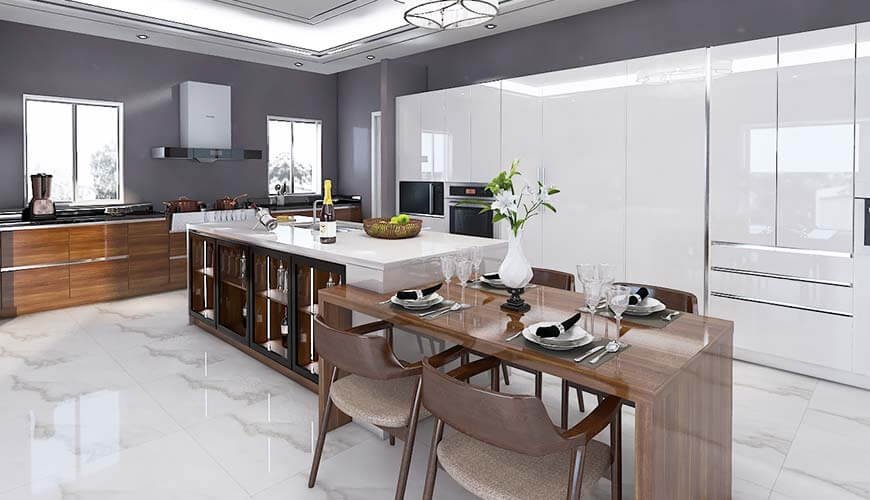Resurfacing kitchen cabinets involves applying a new finish to the existing doors and drawers. Refacing replaces the cabinet doors and drawer fronts entirely.
Resurfacing and refacing kitchen cabinets are popular options for a fresh look without a complete remodel. Resurfacing focuses on applying new materials over the existing surfaces, such as paint or veneer. This method is cost-effective and less invasive. Refacing, on the other hand, replaces the cabinet doors and drawer fronts while retaining the original cabinet structure.
This option offers a more dramatic transformation and allows for updated styles and materials. Both methods can significantly enhance the kitchen’s appearance and value, catering to different budgets and design preferences. Choosing between them depends on the extent of change desired and budget constraints.
Table of Contents
ToggleCost Comparison
Understanding the costs involved in resurfacing and refacing kitchen cabinets is vital. Both methods offer ways to refresh your kitchen but differ in price. Let’s break down the costs into material and labor.
Material Costs
Resurfacing typically involves applying a new laminate or wood veneer over the existing cabinet faces. The cost of materials for resurfacing is generally lower. Expect to spend between $1,000 to $3,000 on materials for a standard kitchen.
Refacing requires new cabinet doors and drawer fronts, which can be pricier. Materials for refacing usually range from $4,000 to $6,000. This higher price tag is due to the need for new doors and custom finishes.
| Method | Material Cost Range |
|---|---|
| Resurfacing | $1,000 – $3,000 |
| Refacing | $4,000 – $6,000 |
Labor Costs
Labor costs can vary based on the complexity of the job and your location.
- Resurfacing: Labor costs for resurfacing are generally lower. You might spend between $500 and $1,500 for labor. This is because resurfacing is less invasive and quicker to complete.
- Refacing: Labor costs for refacing are higher. Expect to pay between $2,000 and $4,000. This is due to the need for precise fitting and more detailed work.
Labor costs for both methods can fluctuate based on your local market rates.
| Method | Labor Cost Range |
|---|---|
| Resurfacing | $500 – $1,500 |
| Refacing | $2,000 – $4,000 |
Overall, resurfacing is generally more affordable than refacing. This is true for both materials and labor. Understanding these costs can help you decide which option fits your budget and needs.

Aesthetic Differences
Choosing between resurfacing and refacing kitchen cabinets can be challenging. Both options offer unique aesthetic benefits. Let’s explore the differences in visual impact and style options.
Visual Impact
Resurfacing kitchen cabinets involves replacing the existing surfaces. This means applying new veneers or laminates to the cabinet fronts. The result is a fresh, modern look. Resurfacing can make old cabinets look brand new. It also allows for changing colors and textures.
Refacing involves replacing the cabinet doors and drawer fronts. The cabinet boxes remain the same. This process gives a completely new appearance. Refacing often includes adding new hardware. This can include knobs, pulls, and hinges. The visual impact is significant, giving a more updated look to the kitchen.
Style Options
Both resurfacing and refacing offer a range of style options. Here’s a quick comparison:
| Option | Resurfacing | Refacing |
|---|---|---|
| Materials | Veneers, Laminates | Wood, MDF, Thermofoil |
| Colors | Wide range | Wide range |
| Textures | Glossy, Matte | Glossy, Matte |
| Hardware | Existing | New |
Resurfacing is best for those who want a quick update. It works well for minor changes in color and texture. Refacing suits those looking for a complete overhaul. It offers more flexibility in styles and materials.
Durability
The durability of kitchen cabinets is crucial for homeowners. Resurfacing and refacing are two popular options. Let’s explore the longevity of each method.
Longevity Of Resurfacing
Resurfacing involves updating the cabinet’s outer layer. This can mean painting or staining the existing surface. Properly done resurfacing can last between 5 to 10 years.
The longevity depends on several factors:
- Quality of materials used
- Skill of the person doing the work
- Frequency of kitchen use
Resurfacing may not hold up well in high-moisture areas. Regular maintenance can extend the lifespan. Minor touch-ups might be required over time.
Longevity Of Refacing
Refacing involves replacing the cabinet doors and drawer fronts. New veneers are applied to the existing structure. Refacing typically lasts between 15 to 20 years.
The factors influencing the longevity include:
- Type of veneer or laminate used
- Quality of installation
- Environmental conditions
Properly installed refacing provides a durable and long-lasting solution. It is more resistant to moisture and wear. Less frequent maintenance is needed compared to resurfacing.

Time Investment
One key factor to consider in kitchen cabinet renovations is time. Understanding the time investment needed for both resurfacing and refacing can help you decide the best option for your kitchen makeover.
Resurfacing Timeframe
Resurfacing kitchen cabinets involves sanding down the existing surface. Then, a new layer of paint or stain is applied. This process can be fairly quick. Typically, it takes 2-3 days to complete.
Here is a quick breakdown of the resurfacing process:
- Day 1: Sanding and prepping the surface
- Day 2: Applying the first coat of paint or stain
- Day 3: Applying additional coats and finishing touches
Refacing Timeframe
Refacing kitchen cabinets involves replacing the cabinet doors and drawer fronts. Veneers are applied to the exterior of the cabinet boxes. This process generally takes 3-5 days to complete.
Below is a typical timeline for the refacing process:
- Day 1: Removing old cabinet doors and drawer fronts
- Day 2: Prepping and cleaning the cabinet boxes
- Day 3-4: Installing new veneers, doors, and drawer fronts
- Day 5: Final adjustments and hardware installation
| Process | Timeframe |
|---|---|
| Resurfacing | 2-3 days |
| Refacing | 3-5 days |
Environmental Impact
Understanding the environmental impact of kitchen renovation is crucial. It helps homeowners make eco-friendly choices. Let’s dive into the sustainability of resurfacing and refacing kitchen cabinets.
Sustainability Of Resurfacing
Resurfacing involves applying a new veneer to existing cabinets. This method keeps the original structure intact. It reduces waste significantly. There’s no need to discard old cabinets. This process minimizes landfill contributions.
Using eco-friendly materials for resurfacing is another plus. Many veneers are made from sustainable resources. They are often sourced from fast-growing trees. This reduces deforestation concerns.
Energy consumption is also lower. Resurfacing doesn’t require new cabinet production. Manufacturing new cabinets consumes more energy. By resurfacing, you save energy and reduce your carbon footprint.
Sustainability Of Refacing
Refacing involves replacing cabinet doors and drawer fronts. The cabinet boxes remain intact. This method also reduces waste. Old cabinet boxes are not discarded. This minimizes landfill contributions.
Many refacing materials are sustainable. Bamboo and recycled wood are popular choices. These materials are eco-friendly and renewable. They reduce the demand for non-sustainable resources.
Energy efficiency is higher with refacing. Less energy is used compared to making new cabinets. This process conserves resources and reduces emissions. Refacing is a smart choice for eco-conscious homeowners.

Diy Vs. Professional Help
When updating kitchen cabinets, you can choose between resurfacing and refacing. Deciding to do it yourself or hire a professional can influence the outcome and cost. This section helps you understand the differences.
Diy Resurfacing
Resurfacing involves applying a new finish to your existing cabinets. This can include sanding, painting, or staining. DIY resurfacing can be cost-effective but requires time and effort.
- Pros:
- Lower cost
- Control over the project
- Personal satisfaction
- Cons:
- Time-consuming
- Requires skill and patience
- Potential for mistakes
Diy Refacing
Refacing means replacing the cabinet doors and drawer fronts while keeping the existing cabinet boxes. DIY refacing can give your kitchen a new look without a full remodel.
- Pros:
- Less expensive than new cabinets
- Faster than a full renovation
- Less mess
- Cons:
- Requires accurate measurements
- Potential for mismatched finishes
- Tools and materials needed
Choosing between DIY resurfacing and refacing depends on your skills and budget. Consider the pros and cons carefully to make the best decision for your kitchen.
Suitability For Different Kitchens
Choosing between resurfacing and refacing kitchen cabinets depends on your kitchen’s needs. Both methods have unique advantages. Understanding the suitability of each option helps in making the right choice.
Ideal Scenarios For Resurfacing
Resurfacing involves giving your cabinets a new look without replacing them. This method is suitable for kitchens where:
- The existing cabinets are in good structural condition.
- You want to change the color or finish of your cabinets.
- The budget is limited, and a full renovation isn’t an option.
- You want a quick and easy update.
Resurfacing is also ideal for homeowners who wish to maintain the current layout of their kitchen. It’s a cost-effective way to refresh the look without major changes.
Ideal Scenarios For Refacing
Refacing involves replacing the cabinet doors and drawer fronts while keeping the existing cabinet structure. This method is suitable for kitchens where:
- The cabinet structure is still strong and durable.
- You want to change the style of your cabinets completely.
- You are looking for a more significant transformation than resurfacing can offer.
- The current cabinets are outdated but still functional.
Refacing is perfect for those who want to achieve a new look with minimal disruption. It provides a fresh appearance while keeping the layout intact.
Both methods offer unique benefits. Choosing the right one depends on your kitchen’s specific needs and your renovation goals.
Frequently Asked Questions
What Is Cabinet Resurfacing?
Cabinet resurfacing involves replacing the cabinet doors and drawer fronts while keeping the existing cabinet framework.
What Is Cabinet Refacing?
Cabinet refacing updates the exterior surfaces of cabinets with new veneers, doors, and hardware without altering the internal structure.
How Long Does Resurfacing Take?
Resurfacing typically takes 3 to 5 days, depending on the kitchen size and complexity of the project.
How Long Does Refacing Take?
Refacing usually takes 2 to 4 days, making it a quicker option than a complete cabinet replacement or resurfacing.
Which Option Is More Cost-effective?
Refacing is generally more cost-effective than resurfacing, as it requires fewer materials and less labor.
Can I Do Resurfacing Myself?
Resurfacing is complex and often requires professional skills. DIY resurfacing is challenging and not recommended.
Can I Diy Cabinet Refacing?
DIY cabinet refacing is possible with the right tools and skills. However, professional installation ensures better results.
Do Both Methods Improve Cabinet Durability?
Yes, both resurfacing and refacing can enhance the durability of your cabinets by using high-quality materials.
Is Painting Part Of Resurfacing?
No, painting is not a part of resurfacing. Resurfacing involves replacing exterior surfaces, not just repainting them.
Which Method Is More Eco-friendly?
Refacing is more eco-friendly as it minimizes waste by reusing the existing cabinet framework and only replacing the exterior parts.
Conclusion
Resurfacing and refacing kitchen cabinets offer distinct advantages. Resurfacing provides a fresh look by updating the exterior. Refacing involves replacing doors and veneers, giving a completely new appearance. Choose the best option based on budget and desired aesthetic. Both methods can enhance your kitchen’s appeal and functionality effectively.

